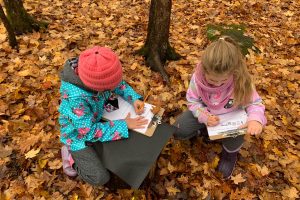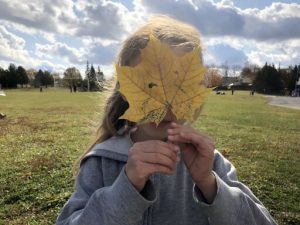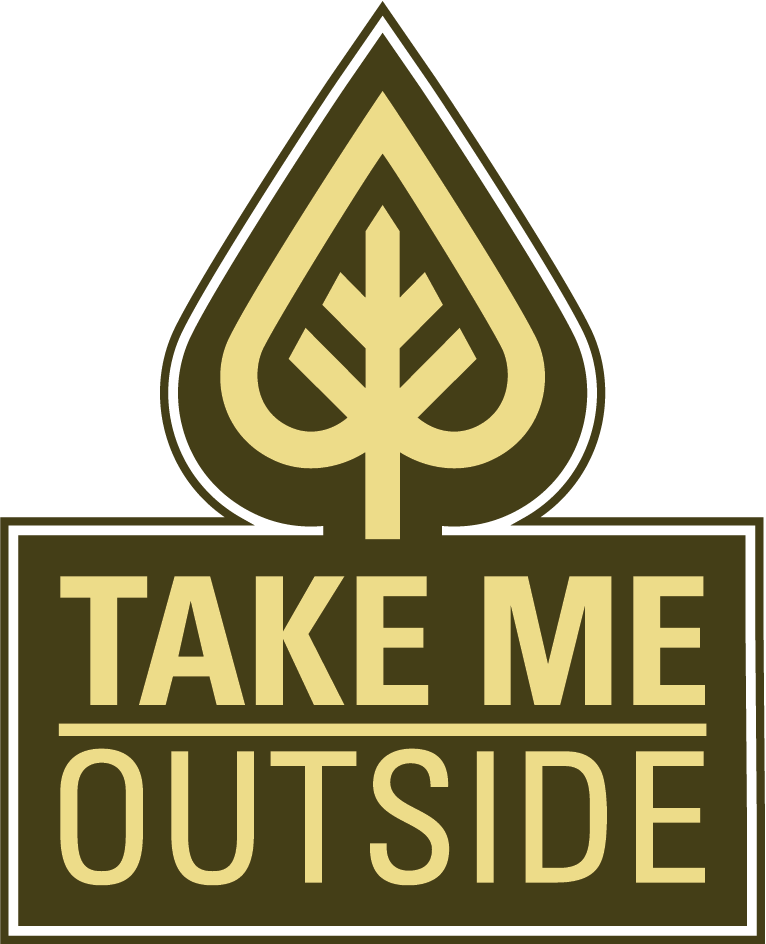November Take Me Outside for Learning Challenge Resources
Nature Scavenger Hunts
Curricular Areas: Math & Art
Target Age Range: Primary (K-7)
 Outdoor scavenger hunts can range from relatively simple to complex. For this activity you can use whatever you have on hand and it can be done in an urban or natural setting. First you will need to have plenty of examples of geometric shapes, either 3D blocks from your classroom or printed out sheets of paper with a variety of geometric shapes cut out of them. Once outside you will get your learners to identify these shapes in the surrounding environment. Where can we see or find triangles? Where can we see or find squares? If you are wanting to extend this activity bring rulers outside with you or string to help measure some of the shapes you find! You can also do this activity but instead of just looking for shapes you can look for examples of bilateral symmetry in nature. Pieces of string or rulers can help students divide natural objects in half to determine if there is symmetry or not. Adapt the symmetry lesson to winter by bring out magnifying glasses or microscopes and analyzing snowflakes! Laminated pieces of black construction paper can help when viewing snowflakes outdoors.
Outdoor scavenger hunts can range from relatively simple to complex. For this activity you can use whatever you have on hand and it can be done in an urban or natural setting. First you will need to have plenty of examples of geometric shapes, either 3D blocks from your classroom or printed out sheets of paper with a variety of geometric shapes cut out of them. Once outside you will get your learners to identify these shapes in the surrounding environment. Where can we see or find triangles? Where can we see or find squares? If you are wanting to extend this activity bring rulers outside with you or string to help measure some of the shapes you find! You can also do this activity but instead of just looking for shapes you can look for examples of bilateral symmetry in nature. Pieces of string or rulers can help students divide natural objects in half to determine if there is symmetry or not. Adapt the symmetry lesson to winter by bring out magnifying glasses or microscopes and analyzing snowflakes! Laminated pieces of black construction paper can help when viewing snowflakes outdoors.
MORE IDEAS FOR NATURE SCAVENGER HUNTS
Fire Building
Curricular Areas: Math & Science & Career/Life/Planning & Social Studies
Target Age Range: Middle/ Secondary
Activity Instructions: Fire building is a skill that lends itself greatly to the outdoor learning environment. Not only does it act as a metaphor to be applied in an English Language Arts context, but the reaction of what elements a fire needs and the chemistry & physics of a fire can easily be spun in a scientific light. In any weather as long as you have some dry tinder you will be able to get a fire going. Furthermore, fires have much significance in many First People’s cultures throughout Canada and can lend itself well to discussions and learning about local First People’s and their culture. If the weather on the day that you intend to build fires is too sassy you can also pivot this lesson to be indoors by projecting a campfire on the overhead in the classroom. This creates a great atmosphere in the room and could also be used to as a warm up activity for an outdoor fire building activity. Make sure to check with your local fire department or municipality about appropriate outdoor spaces for fire building prior to engaging in this activity.

MORE IDEAS FOR AROUND THE CAMPFIRE
Eagle Eye
Curricular Areas: PHE & Social Studies & Science
Target Age Range: All Ages
Activity Instructions: This game is all about animals and their adaptations to assist in everyday survival. As you provide instructions for this activity try to solicit thought and reflection in your students through prompts and questions. Clearly define and set boundaries for this activity. The goal of this activity is to provide students with a lot of time upfront to disguise themselves and come up  with a camouflage so that they can hide successfully as mice in the forest without getting caught by the eagle. After you have clearly set boundaries, explain that in the center of the area you are playing in is the eagle nest, the eagle cannot leave their nest and the eagle will alternate between sleeping and hunting. While the eagle is sleeping, everyone else (the mice) will arise from their hiding spot and try to find a new hiding spot. With each passing round the goal is for the mice to hide successfully as close as possible to the eagles nest without getting caught. When the eagle is awake the eagle tries to hunt for the mice, the eagle can call out to the mice and ask them how many fingers they are holding up. The eagle can also call out “Food for (insert time here)” when this is called the eagle closes its eyes and begins counting down from the designated number, the mice arise from their hiding spot and have to gently tag the eagle on their way to their new hiding spot. It is important to give students ample time to camouflage themselves prior to the first round. The goal is to be sneaky and make adaptations to their natural environment. Once the eagle has caught all the mice, the game is over and a new eagle can be selected for a new round. Always debrief this activity with a discussion surrounding animals & their adaptations.
with a camouflage so that they can hide successfully as mice in the forest without getting caught by the eagle. After you have clearly set boundaries, explain that in the center of the area you are playing in is the eagle nest, the eagle cannot leave their nest and the eagle will alternate between sleeping and hunting. While the eagle is sleeping, everyone else (the mice) will arise from their hiding spot and try to find a new hiding spot. With each passing round the goal is for the mice to hide successfully as close as possible to the eagles nest without getting caught. When the eagle is awake the eagle tries to hunt for the mice, the eagle can call out to the mice and ask them how many fingers they are holding up. The eagle can also call out “Food for (insert time here)” when this is called the eagle closes its eyes and begins counting down from the designated number, the mice arise from their hiding spot and have to gently tag the eagle on their way to their new hiding spot. It is important to give students ample time to camouflage themselves prior to the first round. The goal is to be sneaky and make adaptations to their natural environment. Once the eagle has caught all the mice, the game is over and a new eagle can be selected for a new round. Always debrief this activity with a discussion surrounding animals & their adaptations.






sarah williams
November 5, 2020 (11:55 am)
We just played Eagle Eye outside in the forest near our school…they loved it! The description was a bit confusing since it didn’t specify clearly how the eagle would catch mice but the students were familiar with a game called ‘camoflage’ that helped them fill in the gaps. thanks.